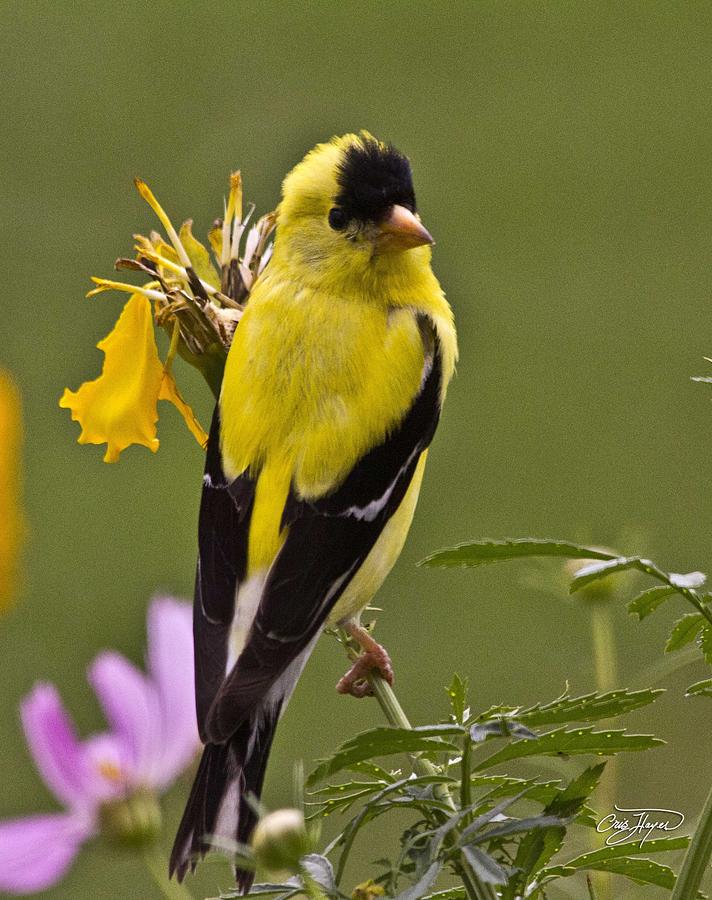
Except during the nesting season, it is a sociable bird that seeks its own kind to feed and fly with. The American Goldfinch prefers trees in open places, especially in orchards and along roadsides. They utter this sound for the first month after they leave the nest until they are completely independent. Shortly before fledging, the young develop a fledging call that sounds like chick-kee or chick-wee.

#Yellow finch full
When he flies over the nest, displaying and calling with his esophagus full of seed, the female responds to her mate’s calls with a soft continuous teeteeteeteete sound. While the female is incubating, or warming, the eggs, she is dependent on her mate for food. At the first sign of danger the male or female will whistle sweet or call bearbee, bearbee, bee, bearbee. When the male accompanies the female to search for nesting materials, he perches nearby, singing and calling to his mate. The American Goldfinch is easily detected in the spring or summer as a flash of yellow, flying with an undulating motion and calling perchicoree, perchicoree. The female has an olive rump instead of a pale one. In summer the adult male is black or olive above, rather than yellow, and he retains the black cap all year. It is slightly smaller than the American Goldfinch, measuring about 10 cm in length. The male’s lesser coverts-the feathers covering the shoulders-are yellow.ĭuring their first autumn and winter the juveniles are wood brown above with buffy, rather than white, wing markings and dull black shoulders, which distinguish them from the adults.Ī bird similar in appearance to the American Goldfinch, the Lesser Goldfinch Carduelis psaltria, is occasionally seen in British Columbia. The face and neck are a pale yellow, only a hint of the bright yellow of summer. Their wings are black with white wing bars, and the black tail is etched with white. They are buff-coloured below and olive brown above. The summer female is olive yellow, with a bib of yellow on her neck and breast.Īfter a complete moult in the fall, the birds grow plumage that is almost identical in colour for both sexes. In flight, a white rump contrasts with the black tail. The male assumes brilliant canary yellow plumage and a striking jet black cap.

In spring the birds moult, or shed, all but their black wing and tail feathers, and the bills of both sexes turn orange. The goldfinch averages 11 cm in length, much the same size as the English Sparrow, and weighs about 11 g. The optimal combination of those lets orange males raise the most chicks (Badyaev & Hill 2002).With its short, heavy, conical beak, the American Goldfinch Carduelis tristis is typical of North American seed-eating birds that are members of the finch ( Fringillidae) family. It’s orange males, who compromise between the colors: fairly early breeding like a red male, a substantial contribution to feeding the babies like a yellow male. In older birds, it isn’t the early-breeding, lazy red males who are the most successful at raising chicks. Males who breed successfully one year seem to be able to be any color they want in the next year. Males who don’t manage to attract a mate one year tend to be redder the next year, hoping to seduce a young female. Some start out yellow and turn red, some start red and turn yellow, some stay red all their lives.

There is a great sequence of photos in Badyaev & Duckworth 2003 showing males over three years. Males don’t necessarily stick with the same color throughout their lifetimes.

It looks like developing red plumage may become easier with age, so that while only great-condition birds can be red in their first year, older birds don’t have to work so hard to get that crimson hue (Badyaev & Duckworth 2003). Or a not-that-awesome older male might be red. LaBarbera.)įor older males, color is not determined as much by their condition: an awesome older male might be yellow, instead of red.


 0 kommentar(er)
0 kommentar(er)
